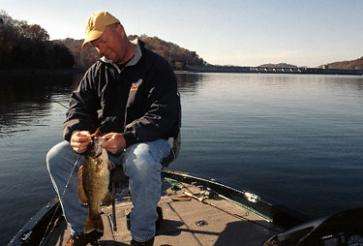
Here in the dead of winter you have to really be on your game to have a great smallmouth trip. In the spring, almost anyone can catch them. They’re hungry and aggressive and more vulnerable than any other time of the year. In the fall, they can be like that, too.
Come summer, I like to go out at night and work a hair jig around deep grass beds. Catching smallies then can be challenging, but nothing like the winter. In the winter, tough fishing is expected.
One of the keys to catching smallmouth in winter is finding the bait and doing the best possible job of imitating it. Since crawfish hibernate in the winter, I don’t try to emulate them at this time of year. Instead, I do what I can to imitate a baitfish. Just what kind of baitfish you want to imitate depends on the body of water you’re fishing and the bait available there.
Another key is to find a way to present that baitfish imitation slowly enough to match the metabolism of winter baitfish and bass. That generally means one of two techniques — the float and fly (which suspends a small hair jig beneath a float so you can move it as slowly as possible) and the suspending jerkbait or crankbait (which can be stopped and will hold in place for long periods of time).
You need to a use a lure that won’t plummet to the bottom when you’re not moving it. The limiting factor with the float and fly and suspending hard baits is how deep you can get them.
A jigging spoon or blade bait could work — and you can get them much deeper — but you’ll have to fish them vertically. They’re great choices for when you’ve pinpointed the bass, but poor search baits.
It’s an old truism that if you can find the bait, you’ve found the bass. That’s as accurate in the winter as at any other time. Baitfish can be patterned just like bass and will respond predictably to weather changes.
In the winter, if there’s been a warm rain, you’ll find the baitfish in the backs of creeks that are dumping warm water into the lake. If the rain was a cold one, they’ll be out in the main lake where temperatures are more stable. After a few warm, sunny days, you can expect the baitfish to move up shallower where the water warms more quickly.
Look for them on your electronics. Typically, they’ll be deeper after a front and near the main lake. Find the lure that best imitates them and that you can fish slowly, and you should be in the action.
Until next time, if you have any questions or comments, I’d love to hear from you. Please e-mail me atStephen@thesmallmouthguru.com.





